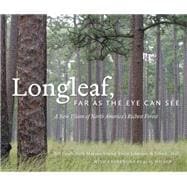Longleaf, Far As the Eye Can See

Longleaf, Far As the Eye Can See
- ISBN 13:
9780807835753
- ISBN 10:
0807835757
- Format: Hardcover
- Copyright: 10/22/2012
- Publisher: Univ of North Carolina Pr
New From $34.75
Sorry, this item is currently unavailable on Knetbooks.com
List Price $36.00 Save $1.25
New
$34.75
Usually Ships in 2-3 Business Days
We Buy This Book Back!
Included with your book
Free Shipping On Every Order
Note: Supplemental materials are not guaranteed with Rental or Used book purchases.
Extend or Purchase Your Rental at Any Time
Need to keep your rental past your due date? At any time before your due date you can extend or purchase your rental through your account.
Summary
Longleaf forests once covered 92 million acres from Texas to Maryland to Florida. These grand old-growth pines were the "alpha tree" of the largest forest ecosystem in North America and have come to define the southern forest. But logging, suppression of fire, deliberate destruction by landowners, and a complex web of other factors reduced those forests so that longleaf is now found only on 3 million acres. Fortunately, the stately tree is enjoying a resurgence of interest, and longleaf forests are once again spreading across the South. Blending a compelling narrative by writers Bill Finch, Rhett Johnson, and John C. Hall with Beth Maynor Young's breathtaking photography, Longleaf, Far as the Eye Can Seeinvites readers to experience the astounding beauty and significance of the majestic longleaf ecosystem. The authors explore the interactions of longleaf with other species, the development of longleaf forests prior to human contact, and the influence of the longleaf on southern culture, as well as ongoing efforts to restore these forests. Part natural history, part conservation advocacy, and part cultural exploration, this book highlights the special nature of longleaf forests and proposes ways to conserve and expand them.








